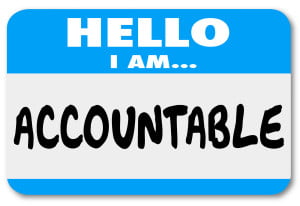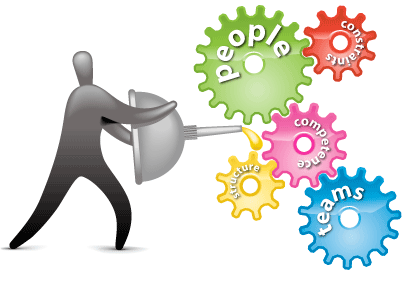 tl,dr:
tl,dr:
There are three parts to making a commitment and maintaining accountability:
- We say we’ll do it.
- We mean it.
- We actually do it.
Say
How we say (or write) things makes a difference. Both for the listener and the speaker.
Non-commitment sounds like this:
- “I hope to finish it this week.”
- “Let’s set up a meeting.”
- “We should take care of that.”
- “I think I can do this today.”
- “I’ll try to do that as soon as possible.”
- “I’ll get started on that today.”
Commitment sounds like this:
- “I will finish this by the end of this week.”
- “I will send out a meeting invitation today.”
- “I will take care of that by Tuesday.”
- “I will do this today.”
- “I’ll get that done by 18:00.”
Notice the differences? The first group of phrases all offer a way out… If we end up not accomplishing the thing we “promised” it doesn’t feel so bad…I mean, we left some loops holes, some wiggle room, right? With the second set, there’s a contract that we’ll feel (at least mildly I hope 🙂 uncomfortable about breaking. It is a subtle and different mindset.
Mean
Deconstructing the building blocks of the language of commitment we hear:
- The word “will”: We will do something (not can, may, might, should, want, or any other inconclusive word). “Will” is stating a fact.
- An expected end time or date. Without this part, the commitment would be fully open to interpretation and would be virtually meaningless. (Use “by” for an end time, not “at”)
- An assumption that the actions are fully under our control
To fine-tune our understanding of the above construction, consider the following two statements:
- “I will fix these five bugs by the end of the week.”
- “I will meet with Joe, and together we’ll decide how to solve this today.”
These may appear to be in the language of commitment, but they really are not: both statements would be committing to things that are not fully under one’s control…e.g., bugs are not always as innocent and easy to fix as they may seem – at least not without a decent amount of discovery; And what if Joe’s not available today…?
On the other hand, I could commit to one or more steps that would lead to the desired goal:
- “I will work at least five hours each day for the next week to solve these bugs.”
- “I will send out a meeting request to Joe today about solving this.
- Also, when faced with a task that doesn’t lend itself to a clear end date, set a time box, and then commit to regroup, replan, and recommit based on what was found.
The “DaveK” Corollary
Say “Yes” to the right things and “No” to everything else. Say “No.” It is ok to say it often. Really. Say it clearly. Be honest. Don’t buffer the time frame. Don’t say what you think the team/individual wants to hear. (For more ways to say “No” see: A Clear “No” Can Be More Graceful Than A Vague Or Noncommittal “Yes”)
The language for this is simple:
- “I can’t commit to that because….”
This approach will give those involved in the conversation the opportunity to discuss the task at hand and perhaps remove roadblocks or distribute workloads that might have gone unmentioned otherwise.
Do (Or do not. There is no try.)
Ok, so you’ve been clear in your language and have made a commitment. What happens if you can’t keep it? Do you pretend we kinda made it? Duck and cover? Seek excuses?
Nah – don’t trash your integrity or the team’s trust in you. Instead, simply raise a red flag as soon as possible when you know you’re not gonna make it… The quicker you do this the better the odds are that your team can help you do something about it.
Getting Started with Accountability
If you are not already speaking in the language of commitment, start today. In team conversations like the daily stand up and with one-on-one discussions. If it feels awkward at first, great! That means you’re pushing the edges of your comfort zone and are on to learning new things.
Speak Honestly, Directly and For Yourself
- Be mindful of speaking only for yourself. Consciously use “I” and “Me.” Do not use “We” “They” “Us” “Everybody” “You” as a place to hide what you really mean to say.
- Speak on your own behalf, not on behalf of others (present or not present)
- Is everyone present who should be? Are you “triangulating” / “pairing”?
- Be clear about your intentions and your expected outcome.
- Don’t ask questions that are not really questions. If you can rephrase something as a statement, is it really a question?
- Don’t ask “Why didn’t you….?” (Which makes the excuse that follows acceptable…) Ask instead:
- Did you know how…?
- Did you know what…?
- Was it important to you…?`
Keep in mind that your teammates may be learning too – so help them, as they will help you. If someone makes a commitment-lite statement or one that is not clear, repeat back in the language of commitment what you think you heard: “So you can commit to working on this for five hours each day, for the next week?” “So you will send out a meeting invite by the end of today?” Hopefully what follows is a “Yes” and then a “Thank you.”
See what changes. Do people take longer to decide if they can commit to something? Is it because they are digging deeper to understand what’s really required? Are our estimations better? And in the end, will our teams move faster because we establish meaningful target deadlines, remove communication mishaps, and actually get done what we say we will?
